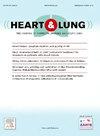Prediction of in-hospital mortality in patients with acute myocardial infarction following primary percutaneous coronary intervention: A machine learning approach
IF 2.6
4区 医学
Q2 CARDIAC & CARDIOVASCULAR SYSTEMS
引用次数: 0
Abstract
Background
In-hospital mortality in patients with acute myocardial infarction (AMI) following primary percutaneous coronary intervention (pPCI) remains a significant concern. Developing a predictive model of in-hospital mortality is crucial for identifying high-risk patients, guiding clinical decisions, and preventing in-hospital mortality. Machine learning (ML) may analyze patterns in large datasets and provide accurate predictions of in-hospital mortality in AMI patients following pPCI.
Objectives
To develop and validate a model for predicting in-hospital mortality in AMI patients following pPCI using ML algorithms.
Methods
1968 AMI patients after pPCI were identified from the SCIENCE database between 2019 and 2023. Four supervised ML algorithms (Random Forest, XGBoost, AdaBoost, and Logistic Regression) were used to construct the models. The performance of the models was evaluated by the area under the curve (AUC), accuracy, sensitivity, specificity, and F1-score.
Results
The overall in-hospital mortality rate was 17.68 %. The model constructed using the Random Forest provided the best performance for discriminating between patients with a status of alive and dead, with an AUC of 0.976. The models constructed from the XGBoost and AdaBoost algorithms had lower discriminatory performance than the RF model, with AUCs of 0.975 and 0.974, respectively. The model based on the LR algorithm had the lowest AUC of 0.973.
Conclusions
A predictive model constructed using the RF algorithm performed the best for predicting in-hospital mortality in AMI patients following pPCI. Implementing the model in a clinical setting may assist nurses/physicians in identifying high-risk patients, prioritizing them for appropriate treatment, and potentially reducing in-hospital mortality.
原发性经皮冠状动脉介入治疗后急性心肌梗死患者住院死亡率预测:机器学习方法
背景:急性心肌梗死(AMI)患者经皮冠状动脉介入治疗(pPCI)后的院内死亡率仍然是一个值得关注的问题。建立院内死亡率预测模型对于识别高危患者、指导临床决策和预防院内死亡率至关重要。机器学习(ML)可以分析大型数据集中的模式,并提供pPCI后AMI患者住院死亡率的准确预测。目的建立并验证使用ML算法预测pPCI后AMI患者住院死亡率的模型。方法从SCIENCE数据库中筛选2019 - 2023年pPCI后AMI患者1968例。四种监督机器学习算法(Random Forest, XGBoost, AdaBoost和Logistic Regression)用于构建模型。通过曲线下面积(AUC)、准确性、敏感性、特异性和f1评分来评价模型的性能。结果住院总死亡率为17.68%。使用随机森林构建的模型对患者生存状态和死亡状态的区分效果最好,AUC为0.976。采用XGBoost和AdaBoost算法构建的模型的区分性能低于RF模型,auc分别为0.975和0.974。基于LR算法的模型AUC最低,为0.973。结论采用RF算法构建的预测模型对急性心肌梗死患者pPCI术后住院死亡率预测效果最好。在临床环境中实施该模型可以帮助护士/医生识别高危患者,优先考虑适当的治疗,并有可能降低住院死亡率。
本文章由计算机程序翻译,如有差异,请以英文原文为准。
求助全文
约1分钟内获得全文
求助全文
来源期刊

Heart & Lung
医学-呼吸系统
CiteScore
4.60
自引率
3.60%
发文量
184
审稿时长
35 days
期刊介绍:
Heart & Lung: The Journal of Cardiopulmonary and Acute Care, the official publication of The American Association of Heart Failure Nurses, presents original, peer-reviewed articles on techniques, advances, investigations, and observations related to the care of patients with acute and critical illness and patients with chronic cardiac or pulmonary disorders.
The Journal''s acute care articles focus on the care of hospitalized patients, including those in the critical and acute care settings. Because most patients who are hospitalized in acute and critical care settings have chronic conditions, we are also interested in the chronically critically ill, the care of patients with chronic cardiopulmonary disorders, their rehabilitation, and disease prevention. The Journal''s heart failure articles focus on all aspects of the care of patients with this condition. Manuscripts that are relevant to populations across the human lifespan are welcome.
 求助内容:
求助内容: 应助结果提醒方式:
应助结果提醒方式:


